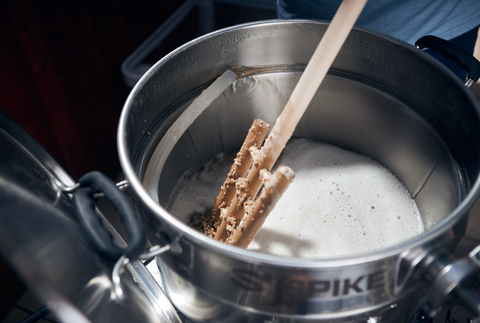By Maria Podetz
They’ve been put through the grind and smashed around, they’ve been pushed to their absolute boiling point at times, they’re absolutely drained and thoroughly used up, they’re exhausted,washed out and some might even go so far as to say they’re absolutely spent. But does this have to be the end? Or is there life after lauter for precious spent beer grain?


What are Spent Beer Grains?
Spent beer grain is leftover grains/malt after sugar extraction within the mashing and lautering steps of the brewing process. This by-product of the beer making process is often needlessly discarded following completion of the brewing process, leading to the dreaded Grain Guilt.
Grain Guilt: we’ve all felt it as beer brewers; you’ve just finished your lauter and look down at your basket of hard-working freshly steeped grain, only to find it proudly gazing back up at you after it just gave you it’s absolute best— it’s exhausted and absolutely spent. Suddenly, your brewer face changes from thankful to sullen as you realize that your dedicated little spent grains are doomed to die a single-use death in the compost alongside the empty promises of last week’s celery. Our spent grain deserves more than a rotten celery-death, so Grain Guilt-be-gone, because we’re about to get crafty with alternative uses for those little spent grains that could, and still can!

Nutritional Benefits of Spent Grains
Spent grain has high concentrations of dietary fiber, protein, and phenolic compounds that all offer various health benefits. In human foods, spent beer grain is nutrient-dense, with far more fibre and protein than traditional bread-grains, which will minimize caloric intake of foods such as breads, cakes, muffins, crackers, and quick-grab snacks. Studies have also shown that animal diets rich in spent grain facilitates increased milk yields, higher fat contents in milk, and provide essential amino acids. Moo-yeah!

High in Fiber and Protein
Integrating spent grain into your food may increase fiber and protein intake within your diet. Since the brewing process removes most of the starch present in barley, spent beer grain has a much higher concentration of protein and fibre than pre-brewed barley and other grains in-general. Composed of an impressive 20% protein and 70% fibre, consuming spent beer grain as part of a balanced diet can support weight loss and possibly improve digestion.
Finally, spent beer grain has substantial levels of the essential amino acid, lysine, which is not produced within our bodies and must therefore be consumed within our diets. Lysine aids in the body’s calcium absorption and boosts collagen-production, which supports healthy bones, connective tissues, tendons, cartilage, hair, skin, and nails, and even slows visual aging and heals skin wounds faster.
But as always please, check with your licensed medical professional before consuming copious amounts of spent grain please and thank you!

Vitamins and Minerals
Since it’s rich in minerals and water-soluble vitamins such as folic acid, thiamine, niacin, riboflavin, calcium, magnesium, phosphorus, and sodium, you can put that $8 mineral water back on the shelf and instead hawk a spoon full of your spent beer grain to increase your micronutrient intake.
Antioxidants
Spent beer grain has phenolic acids and concentrated hydroxycinnamic acids, which have many biofunctions, such as antioxidant, anticarcinogenic, antiatherogenic and anti-inflammatory activities.

Uses of Spent Grains
Eat it, bake it, sauté it—they're all good! But the first step is to convert the spent grain into flour before we bake or cook with it. Here’s how:
Step 1 Storage: Preserving Spent Beer Grain After Lautering
1) Time to get out those giant brewing muscles you’ve been training! You’ll need to start straining your spent grain of as much liquid as humanly possible by hand as soon as it has cooled enough from the lauter to handle. I like using a strong layered cheese cloth or dish cloth for this task and really get in there to wring-out the spent grain.
2) Throw thoroughly strained beer grain into food-safe plastic bags and place in the refrigerator (or freezer) until you’re ready to dehydrate it.
*Spent beer grain will keep in the refrigerator for no more than 3 days, and will keep in the freezer for 2-3 months.
Step 2 Preparation: Drying Spent Beer Grain for Consumption
1) Preheat oven to lowest possible temperature
2) Line baking sheet(s) with parchment paper
3) Place strained/thawed spent grain in even single layers on baking sheet(s)
4) Roast spent grains for 7-8 hours, removing from oven and stirring grain to redistribute around baking sheet(s) every couple of hours
*Your grain is finished drying when you can feel absolutely no moisture
5) Remove grain from oven and set aside to cool to room temperature
6) Once at room temperature, store in pantry as whole grain for later processing, or immediately pulverize with food processor, blender, etc. to flour consistency and store for later usage
Step 3 Creation: Spent Beer Grain Recipes
From spent grain granola clusters, to pizza and pie crusts, to bread, pancakes, cookies, and everything in between, Homebrew Academy is my go-to for tried and true spent beer grain recipes.
A friendly note that spent grain flour is typically used in conjunction with other flours and does not comprise 100% of flour within most recipes. So, if you’re going to use spent grain flour in one of your own traditional recipes, stick with replacing only up to ¼ cup of spent grain flour per 1 cup of conventional flour and add ¼ additional baking soda/powder.

Animal Feed & Treats
One of the most common uses for spent beer grain is livestock feed; many brewers donate spent beer grain to local farmers and gladly accept high-grade meat cuts as thank-yous in return. Since beer grain contains high levels of protein, fibre, and other nutrients, you know you’ll be getting a top-notch steak, pork chop, or chicken breast from a spent grain-fed animal.
Domestic pets also benefit from the nutrient-dense grain via homemade animal treats using spent beer grain. If you like to spoil your pup, we’ve got a great recipe you can reference on our Instagram account: @BeerBrewnettes
PSA: Spent grain pet treats also make amazing gifts for holidays and celebrations!
As always please, check with your local veterinarian before letting your four legged friend consume copious amounts of spent grain please and thank you!

Composting
Spent grain is rich in nitrogen, which is essential for plant growth. If you add spent grain to your compost or use it as garden mulch, your soil health will be greatly improved, and you’ll also be supporting sustainable agriculture.
Biofuel Production
Ethanol, used as a renewable fuel source for vehicles, is created via a process that ferments carbohydrates. Spent beer grain has been used to sustainably produce this biofuel, reducing reliance on fossil fuels. Giddyup!
Mushroom Cultivation
Spent beer grain is high in protein and cellulose, making it an appealing growing substrate for fungi because fungi feeds on cellulose. While it can be tricky to use spent grain in this way, mushroom farms have even reported that the rooting structure of mushrooms (mycelia) roots 3 times as quickly with certain fungi when utilizing spent beer grain as compared to traditional means. And, bonus, once the spent grain has finished being used for a second time, it can then be composted as a third usage!
Wrap it Up
Spent beer grain offers bountiful opportunities to be used again and again and all you have to do is grab a dish towel and make a little freezer space before your next Brew Day. So, sip on spent grain potential for a while and then take a big gulp when Brew Day happens. Your little grains will thank you. Prost!

An avid homebrewer, Maria resides in Nova Scotia, Canada, where she thoughtfully creates beer from her little green backyard brew barn. Co-founder of the @BeerBrewnettes social media platforms, Maria helps to create and publish daily content on all things beer-related: for homebrewers and beer-lovers alike, you can join the adventures of the two Beer Brewnettes on YouTube, Instagram, and Facebook via https://linktr.ee/BeerBrewnettes
References:
Food Science
Composition and Nutrient Value Proposition of Brewers Spent Grain
https://ift.onlinelibrary.wiley.com/doi/10.1111/1750-3841.13794
Plant Chicago
Spent Grains in Mushroom Growing
https://www.plantchicago.org/post/spent-grains-in-mushroom-growing





